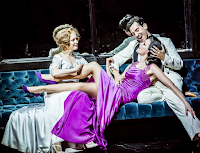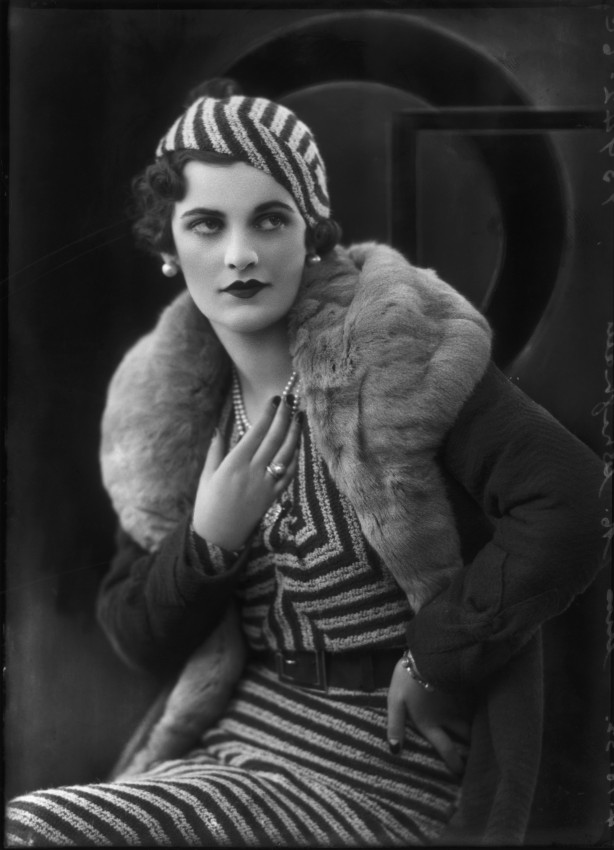Adès - Powder Her Face
La Monnaie (at Halles de Schaerbeek), Brussels, Sunday September 27 2015.
Conductor: Alejo Pérez. Production: Mariusz Trelinski. Sets: Boris Kudlicka. Costumes: Marek Adamski. Lighting: Felice Ross. Video: Bartek Macias. Duchess: Allison Cook. Hotel Manager, Duke, Laundryman, Other guest: Peter Coleman-Wright. Electrician, Lounge Lizard, Waiter, Priest, Rubbernecker, Delivery boy: Leonardo Capalbo. Maid, Confidante, Waitress, Mistress, Rubbernecker, Society journalist: Kerstin Avemo. La Monnaie orchestra.
Brussels’ royal opera house is shut for renovation, so this season is peripatetic. On account of work, I missed what was apparently a fun (and more) production of L'Elisir d'Amore at the Cirque Royal two weeks back, being in Muscat instead. Powder Her Face took us to a former market hall in Schaerbeek, up near the Nord station, where the streets are lined with Turkish grocers’, cafés, restaurants and cake shops. So for a change, on an unusually sunny day for Brussels, we had Urfa kebabı, İskender and künefe for lunch before the show.
It’s always hard to form an opinion of a production of a work you don’t know. But having read the libretto (with its stage directions) and reviews of other productions, it seems to me Trelinski’s relentlessly dark-and-sleek-and-shiny-but-sordid approach, fiddling with the action, actually diminished the work’s dramatic potential. I would imagine UK productions, at least, would have been a bit more “Shakespearean”, with irony, even fun, up front making the tragic end more tragic. In Trelinksi’s version, the Duchess, more a Lulu-like victim than a former deb of the year, staggers around in a dazed, drugged or drunken stupor from start to finish, slashing her wrists in the bath at the end (rather than walking off with the gramophone, as suggested in the stage directions); any humour is kind-of-forced upon the reluctant director by the text and score.
Conductor: Alejo Pérez. Production: Mariusz Trelinski. Sets: Boris Kudlicka. Costumes: Marek Adamski. Lighting: Felice Ross. Video: Bartek Macias. Duchess: Allison Cook. Hotel Manager, Duke, Laundryman, Other guest: Peter Coleman-Wright. Electrician, Lounge Lizard, Waiter, Priest, Rubbernecker, Delivery boy: Leonardo Capalbo. Maid, Confidante, Waitress, Mistress, Rubbernecker, Society journalist: Kerstin Avemo. La Monnaie orchestra.
 |
| Thomas Adès |
It’s always hard to form an opinion of a production of a work you don’t know. But having read the libretto (with its stage directions) and reviews of other productions, it seems to me Trelinski’s relentlessly dark-and-sleek-and-shiny-but-sordid approach, fiddling with the action, actually diminished the work’s dramatic potential. I would imagine UK productions, at least, would have been a bit more “Shakespearean”, with irony, even fun, up front making the tragic end more tragic. In Trelinksi’s version, the Duchess, more a Lulu-like victim than a former deb of the year, staggers around in a dazed, drugged or drunken stupor from start to finish, slashing her wrists in the bath at the end (rather than walking off with the gramophone, as suggested in the stage directions); any humour is kind-of-forced upon the reluctant director by the text and score.
As to fiddling with the action… Unless I was more than usually inattentive, the 1936 13-scene “pantomime” – surely quite an important bit of business? - was simply ditched: the Maid as Waitress sang her extraordinary “Fancy Aria” in front of a dazzling tinsel curtain. The famous fellatio scene was here set in a Hopper-esque American petrol (i.e. “gas”) station, with a small diner to the left and petrol pumps to the right (not vice-versa as in Hopper's painting), and the Duchess drove on in a little red MG – a distinctly British choice in the this distinctly un-British setting. This made her attempts to call for room service, from a pay-phone on the diner wall, senseless and looked to me like directorial self-indulgence. The fellation was soon sex, first frontal, then anal.
For the record… The old market hall, totally blacked out, offered plenty of space for the action. The chamber orchestra was up at the back, behind us. On the left was the long, fancily-papered wall of a hotel corridor, with wall lights and numbered doors. It was used for black-and-white projections of pre-war footage evoking, e.g. the Duchess’s first marriage. On the right, a nod to Amsterdam’s red-light district, was (sometimes) the graffiti-marked façade of what was presumably some sort of sex club, with muscular young men, bare-chested in leather and masks, writhing in strobe lights behind the unwashed windows. Twice the Duchess entered under the “Open” neon sign.
The main stage, with a revolving ring bringing on and taking off props, was glossy black marble with a central inlay. This black gloss, the overall design scheme and the Duchess’s costumes and demeanour reminded me of the boring “glam-trash” perfume commercials that come on TV around Christmas (intentionally? Her scent – Joy - is mentioned in the text, and in this production she slashes her veins with the broken bottle). It opened with the Duchess’s bathroom, but was at other times the Savoy lobby, with revolving doors; an art deco living room with a giant satin couch; a bedroom for the court scene, with the Duke/Judge emerging form under the covers and the Rubberneckers watching events on TV, eating crisps from a decidedly un-50s plastic bag; that Hopper-esque petrol station; or hidden by the aforementioned tinsel curtain. The Maid and Electrician, at the end, were replaced by child tango dancers in Fred-and-Ginger outfits.
Musically the afternoon was excellent. Perhaps the orchestra could have been a bit more incisive; perhaps the scenes could have been driven by with a touch more impetus; but perhaps that was just me. With such a strong cast, it would be nitpicking to single out minor shortcomings that might anyway have been figments of my drowsy, Sunday-afternoon imagination. So though it may look like a cop-out, I'll just say a big bravo to them all for both singing and acting, and hope to see some or all of them again, in new repertoire or old.





Comments
Post a Comment